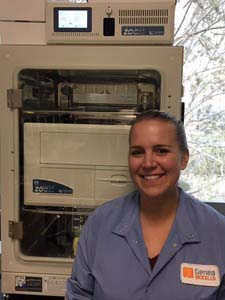Posted by George Shaw on Oct 28, 2016

Reprinted from Genea Biocells October Newsletter.
The newest member of our team at Genea Biocells has been collecting data 24 hours per day, 7 days per week without complaint! Addition of the Essen Bioscience IncuCyte live cell imaging microscope to the lab has given us the added capability of timelapse analysing up to 2304 samples at a time. This new system lives inside an incubator and automatically takes time lapse phase and fluorescence photos of our cells up to once a minute for as long as desired. Analysis of these images is helping us to understand how the cells are behaving in terms of growth, morphology and death.The IncuCyte system will also benefit our contract research customers as it adds additional live cell-based assays and long-term cell monitoring to our extensive suite of available analyses.
Our first application for this technology is our Facioscapulohumeral Muscular Dystrophy (FSHD) disease modelling and drug discovery. Following publication of our recent paper, which established hPSC derived skeletal muscle differentiation and FSHD phenotypes (Caron et. al. 2016), we are now able to monitor these FSHD affected cells in real time in order to find methods for rescuing the disease effects. Essentially we are monitoring hundreds of different conditions, including potential treatments, that affect FSHD muscle cells over time, all in a single experiment that runs while we sleep.
In the future we plan to extend application of this technology to other diseases and additional platorms like fluorescence-based reporters and live cell dyes. The potential applications in identifying new phenotypes in disease-affected muscle and neuronal cells derived from our hESC bank make this new equipment an essential member of our team and a necessary step to move forward with therapeutics development.
The IncuCyte will also be used by our cell and media production team to monitor growth and differentiation rates of different cell lines, different culture conditions and for optimizing media formulations. While traditional microscopy offers a snapshot-based approach to cell biology at a single time point, live cell imaging gives us the data-packed resolution of a feature-length film. We're looking forward to reporting more scientific progress from our new movie director's chair!
For more information feel free to contact us directly at info@geneabiocells.com or visit our website www.geneabiocells.com





Connect with us on social media